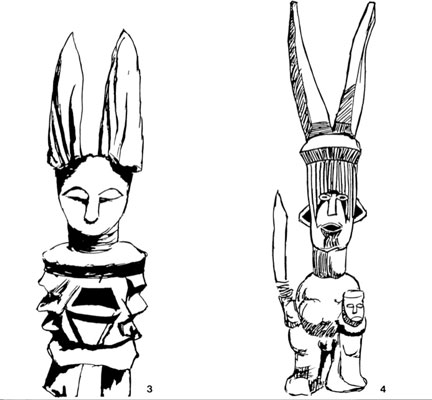Ikenga Symbolism and Classification
June 18, 2012 1 Comment
The Igbo tribe (primarily inhabiting southeastern Nigeria), make up one of the largest and most influential ethnic groups in Nigeria, numbering approximately 46-49 million people. Due to the effects of migration and the Atlantic slave trade, there are descendant ethnic Igbo populations in countries such as Cameroon and Equatorial Guinea, as well as outside Africa. Their exact population outside Africa is unknown, but today many African Americans and Afro Caribbeans are of Igbo descent.[1]
For the person collecting African Tribal Art the Ikenga is a true find. The carving can be artistically abstract, represents a value system linked to societal advancement, but at the same time provides a physical manifestation of a supernatural link. The primary ideas behind an Ikenga carving are physical strength, determination, and will to succeed. Although typically used as a ritualized figure for Igbo men and groups, the symbolism of Ikenga has survived over the years to provide a cultural basis for components of a related value system, and connects historical with modern motifs of individual wealth, and capitalistic principles.
“The two ram horns means that the owner of the Ikenga must go ahead in his business with the stubbornness of a ram. The knife is his right hand means that he must cut down any obstacle on the way… Every Ikenga must be carved straight and rigid, because straightness is the sign of exactitude, and rigidity means perseverance.” (Onwuejeogwu 1972:92)
The notions of individual enterprise, determination, and achievement are the mainstay of Igbo personality:
“an essential aspect of ‘right and natural’ that talent should lead to enterprise, enterprise to promotion, and promotion to privilege”. (Basil Davidson 1969:25).
Four basic forms of carved Ikenga were identified,[Ritual Enactment of Achievement] [2]
Fig 1. This is the sculptured Ikenga object type.
Fig 2. The abstract Ikenga type with the body in cylindrical form.
Fig. 3 Another abstract Ikenga symbol form.
Fig. 4 This is a figure of a typical Ikenga symbol object belonging to the broad class of “less abstract and more humanistic type”. Note the sitting position of the human figure, the scarification marks (ichi) on the face, the matchet and the human skull in the right and left hands respectively.
[2] Ritual Enactment of Achievement: “Ikenga” Symbol in Igboland ; Ejizu, Christopher I., Paideuma, Bd. 37 (1991), pp 233-251.





Concerning *Ikenga* or perhaps referrd to as “SKengas”, understandng Ibo / Igbo (death) spiritual belief as well as their burial ideology – precolonial European hegemony is a NECESSITY.
The Ibos / Igbo ARE among the “black” migratory ancient Hebrew lineage. The Lemba, Igala, Yoruba, and Ashanti peoples are a few others. Culturally, this often ignored and inconvenient reality must be realized…